Research on the Open-Categorical Classification of the Internet-of-Things Based on Generative Adversarial Networks
Abstract
:1. Introduction
- We propose an OCC algorithm based on improving GAN.
- According to the theoretical basis of OCC, this paper analyzes the feature distribution generated by GAN and the performance of the trained discriminator.
- We use the measured IoT data to conduct experiments, and compare the proposed algorithm with other related work about OCC.
2. Related Work
2.1. Physical Layer Security
2.2. Open-Categorical Classification
2.3. Generative Adversarial Networks
3. Network Overview
3.1. GAN Model
3.2. Wireless Signals GAN Model
4. Open-Categorical Classification Based On GAN
5. Experimental Result
6. Conclusions
Author Contributions
Funding
Acknowledgments
Conflicts of Interest
Abbreviations
| IoT | internet-of-things |
| DDoS | Distributed Denial of Servic |
| OCC | Open-Categorical Classification |
| GAN | Generative Adversarial Networks |
| OCC-GAN | Open-Categorical Classification based on Generative Adversarial Networks |
| SVM | Support Vector Machine |
| OC-SVM | One-Class Support Vector Machine |
| OvR-SVM | One-versus-Rest Multi-Label Support Vector Machine |
| WGAN | Wasserstein Generative Adversarial Networks |
| DCGAN | Deep Convolutional Generative Adversarial Networks |
| ACGAN | Auxiliary Classifier Generative Adversarial Networks |
References
- Fortino, G.; Russo, W.; Savaglio, C.; Viroli, M.; Zhou, M. Modeling opportunistic iot services in open iot ecosystems. In Proceedings of the 17th Workshop from Objects to Agents WOA, Catania, Italy, 29–30 July 2017; pp. 90–95. [Google Scholar]
- Molina, B.; Palau, C.E.; Fortino, G.; Guerrieri, A.; Savaglio, C. Empowering smart cities through interoperable Sensor Network Enablers. In Proceedings of the 2014 IEEE International Conference on Systems, Man and Cybernetics (SMC), San Diego, CA, USA, 5–8 October 2014; pp. 7–12. [Google Scholar]
- Middleton, P.; Kjeldsen, P.; Tully, J. Forecast: The internet-of-things, worldwide, 2013. Garter Res. 2013, 8–15. [Google Scholar]
- Fortino, G.; Rovella, A.; Russo, W.; Savaglio, C. Towards cyberphysical digital libraries: Integrating IoT smart objects into digital libraries. In Management of Cyber Physical Objects in the Future Internet-of-Things; Springer: Cham, Switzerland, 2016; pp. 135–156. [Google Scholar]
- Guan, Z.; Li, J.; Wu, L.; Zhang, Y.; Wu, J.; Du, X. Achieving efficient and secure data acquisition for cloud-supported internet of things in smart grid. IEEE Internet Things J. 2017, 4, 1934–1944. [Google Scholar] [CrossRef]
- Wu, L.; Du, X.; Wu, J. Effective defense schemes for phishing attacks on mobile computing platforms. IEEE Trans. Veh. Technol. 2016, 65, 23–41. [Google Scholar] [CrossRef]
- Cheng, Y.; Fu, X.; Du, X.; Luo, B.; Guizani, M. A lightweight live memory forensic approach based on hardware virtualization. Inf. Sci. 2017, 379, 6678–6691. [Google Scholar] [CrossRef]
- Du, X.; Xiao, Y.; Guizani, M.; Chen, H.H. An effective key management scheme for heterogeneous sensor networks. Ad Hoc Netw. 2007, 5, 24–34. [Google Scholar] [CrossRef]
- Du, X.; Guizani, M.; Xiao, Y.; Chen, H.H. A routing-driven elliptic curve cryptography based key management scheme for heterogeneous sensor networks. IEEE Trans. Wirel. Commun. 2009, 8, 1223–1229. [Google Scholar] [CrossRef]
- Kristi Rawlinson, H. HP News. 2014. Available online: http://www8.hp.com/us/en/hp-news/press-release.html?id=1744676#.W8RtW9UzaUl (accessed on 31 October 2018).
- Hilton, S. Dyn Analysis Summary of Friday October 21 Attack. October 2016. Available online: https://dyn.com/blog/dyn-analysis-summary-of-friday-october-21-attack/ (accessed on 31 October 2018).
- Granjal, J.; Monteiro, E.; Silva, J.S. Network-layer security for the internet-of-things using TinyOS and BLIP. Int. J. Commun. Syst. 2014, 27, 1938–1963. [Google Scholar] [CrossRef]
- Granjal, J.; Monteiro, E.; Silva, J.S. Enabling network-layer security on IPv6 wireless sensor networks. In Proceedings of the 2010 IEEE Global Telecommunications Conference (GLOBECOM 2010), Miami, FL, USA, 6–10 December 2010; pp. 1–6. [Google Scholar]
- Guo, F.; Chiueh, T. Sequence number-based MAC address spoof detection. In Proceedings of the International Workshop on Recent Advances in Intrusion Detection, Seattle, WA, USA, 7–9 September 2005; pp. 309–329. [Google Scholar]
- Ma, M.; He, D.; Kumar, N.; Choo, K.K.R.; Chen, J. Certificateless searchable public key encryption scheme for industrial internet-of-things. IEEE Trans. Ind. Inform. 2018, 14, 759–767. [Google Scholar] [CrossRef]
- Handel, T.G.; Sandford, M.T. Hiding data in the OSI network model. In Proceedings of the 1996 International Workshop on Information Hiding, Cambridge, UK, 30 May–1 June 1996; pp. 23–38. [Google Scholar]
- Peterson, L.E. K-nearest neighbor. Scholarpedia 2009, 4, 1883. [Google Scholar] [CrossRef]
- Rumelhart, D.E.; Hinton, G.E.; Williams, R.J. Learning representations by back-propagating errors. Nature 1986, 323, 533. [Google Scholar] [CrossRef]
- Hearst, M.A.; Dumais, S.T.; Osuna, E.; Platt, J.; Scholkopf, B. Support vector machines. IEEE Intell. Syst. Appl. 1998, 13, 18–28. [Google Scholar] [CrossRef]
- Zhao, C.; Huang, M.; Huang, L.; Du, X.; Guizani, M. A robust authentication scheme based on physical-layer phase noise fingerprint for emerging wireless networks. Comput. Netw. 2017, 128, 164–171. [Google Scholar] [CrossRef]
- Azarmehr, M.; Mehta, A.; Rashidzadeh, R. Wireless device identification using oscillator control voltage as RF fingerprint. In Proceedings of the 2017 IEEE 30th Canadian Conference on Electrical and Computer Engineering (CCECE), Windsor, ON, Canada, 30 April–3 May 2017; pp. 1–4. [Google Scholar]
- Rehman, S.U.; Sowerby, K.W.; Alam, S.; Ardekani, I. Radio frequency fingerprinting and its challenges. In Proceedings of the 2014 IEEE Conference on Communications and Network Security (CNS), San Francisco, CA, USA, 29–31 October 2014; pp. 496–497. [Google Scholar]
- Ramos, S.; Gehrig, S.; Pinggera, P.; Franke, U.; Rother, C. Detecting unexpected obstacles for self-driving cars: Fusing deep learning and geometric modeling. In Proceedings of the 2017 IEEE Intelligent Vehicles Symposium (IV), Los Angeles, CA, USA, 11–14 June 2017; pp. 1025–1032. [Google Scholar]
- Bapst, A.B.; Tran, J.; Koch, M.W.; Moya, M.M.; Swahn, R. Open set recognition of aircraft in aerial imagery using synthetic template models. In Proceedings of the Automatic Target Recognition XXVII, Anaheim, CA, USA, 1 May 2017; p. 1020206. [Google Scholar]
- Patil, H.; Basu, T. Comparison of subband cepstrum and Mel cepstrum for open set speaker classification. In Proceedings of the 2004 First India Annual Conference (INDICON 2004), Kharagpur, India, 20–22 December 2004; pp. 35–40. [Google Scholar]
- Prakhya, S.; Venkataram, V.; Kalita, J. Open-Set Deep Learning for Text Classification. In Machine Learning in Computer Vision and Natural Language Processing; ACM: New York, NY, USA, 2017; pp. 1–6. [Google Scholar]
- Shu, L.; Xu, H.; Liu, B. Doc: Deep open classification of text documents. arXiv, 2017; arXiv:1709.08716. [Google Scholar]
- Shi, Z.; Huang, M.; Zhao, C.; Huang, L.; Du, X.; Zhao, Y. Detection of LSSUAV using hash fingerprint based SVDD. In Proceedings of the 2017 IEEE International Conference on Communications (ICC), Paris, France, 21–25 May 2017; pp. 1–5. [Google Scholar]
- Ayadi, A.; Ghorbel, O.; Obeid, A.M.; Abid, M. Outlier detection approaches for wireless sensor networks: A survey. Comput. Netw. 2017, 129, 319–333. [Google Scholar] [CrossRef]
- Cuccovillo, L.; Aichroth, P. Open-set microphone classification via blind channel analysis. In Proceedings of the 2016 IEEE International Conference on Acoustics, Speech and Signal Processing (ICASSP), Shanghai, China, 20–25 March 2016; pp. 2074–2078. [Google Scholar]
- Blouvshtein, L.; Cohen-Or, D. Outlier Detection for Robust Multi-dimensional Scaling. arXiv, 2018; arXiv:1802.02341. [Google Scholar] [CrossRef] [PubMed]
- Sayyed, S.; Deolekar, R. A survey on novelty detection using level set methods. In Proceedings of the 2017 International Conference on Inventive Communication and Computational Technologies (ICICCT), Coimbatore, India, 10–11 March 2017; pp. 415–418. [Google Scholar]
- Wienke, D.; Kateman, G. Adaptive resonance theory based artificial neural networks for treatment of open-category problems in chemical pattern recognition-application to UV-Vis and IR spectroscopy. Chemom. Intell. Lab. Syst. 1994, 23, 309–329. [Google Scholar] [CrossRef]
- Schölkopf, B.; Platt, J.C.; Shawe-Taylor, J.; Smola, A.J.; Williamson, R.C. Estimating the support of a high-dimensional distribution. Neural Comput. 2001, 13, 1443–1471. [Google Scholar] [CrossRef] [PubMed]
- Scheirer, W.J.; de Rezende Rocha, A.; Sapkota, A.; Boult, T.E. Toward open set recognition. IEEE Trans. Pattern Anal. Mach. Intell. 2013, 35, 1757–1772. [Google Scholar] [CrossRef] [PubMed]
- Scheirer, W.J.; Jain, L.P.; Boult, T.E. Probability models for open set recognition. IEEE Trans. Pattern Anal. Mach. Intell. 2014, 36, 2317–2324. [Google Scholar] [CrossRef] [PubMed]
- Mao, C.; Yao, L.; Luo, Y. Distribution Networks for Open Set Learning. arXiv, 2018; arXiv:1809.08106. [Google Scholar]
- Chen, L.; Srivastava, S.; Duan, Z.; Xu, C. Deep cross-modal audio-visual generation. In Proceedings of the on Thematic Workshops of ACM Multimedia 2017, Mountain View, CA, USA, 23–27 October 2017; pp. 349–357. [Google Scholar]
- Lotter, W.; Kreiman, G.; Cox, D. Unsupervised learning of visual structure using predictive generative networks. arXiv, 2015; arXiv:1511.06380. [Google Scholar]
- Ledig, C.; Theis, L.; Huszár, F.; Caballero, J.; Cunningham, A.; Acosta, A.; Aitken, A.P.; Tejani, A.; Totz, J.; Wang, Z.; et al. Photo-Realistic Single Image Super-Resolution Using a Generative Adversarial Network. In Proceedings of the 2017 IEEE Conference on Computer Vision and Pattern Recognition (CVPR), Honolulu, HI, USA, 21–26 July 2017; pp. 4681–4690. [Google Scholar]
- Yu, L.; Zhang, W.; Wang, J.; Yu, Y. SeqGAN: Sequence Generative Adversarial Nets with Policy Gradient. In Proceedings of the Thirty-First AAAI Conference on Artificial Intelligence, San Francisco, CA, USA, 4–9 February 2017; pp. 2852–2858. [Google Scholar]
- Goodfellow, I.; Pouget-Abadie, J.; Mirza, M.; Xu, B.; Warde-Farley, D.; Ozair, S.; Courville, A.; Bengio, Y. Generative adversarial nets. In Proceedings of the 2014 Advances in Neural Information Processing Systems, Montreal, QC, Canada, 8–13 December 2014; pp. 2672–2680. [Google Scholar]
- Gauthier, J. Conditional generative adversarial nets for convolutional face generation. In Proceedings of the Class Project for Stanford CS231N: Convolutional Neural Networks for Visual Recognition, Winter semester, Palo Alt, CA, USA, 25 March 2015; pp. 1–9. [Google Scholar]
- Radford, A.; Metz, L.; Chintala, S. Unsupervised representation learning with deep convolutional generative adversarial networks. arXiv, 2015; arXiv:1511.06434. [Google Scholar]
- Arjovsky, M.; Chintala, S.; Bottou, L. Wasserstein gan. arXiv, 2017; arXiv:1701.07875. [Google Scholar]
- Jain, L.P.; Scheirer, W.J.; Boult, T.E. Multi-class open set recognition using probability of inclusion. In Proceedings of the European Conference on Computer Vision, Zurich, Switzerland, 6–12 September 2014; pp. 393–409. [Google Scholar]
- Yu, Y.; Qu, W.Y.; Li, N.; Guo, Z. Open-category classification by adversarial sample generation. arXiv, 2017; arXiv:1705.08722. [Google Scholar]

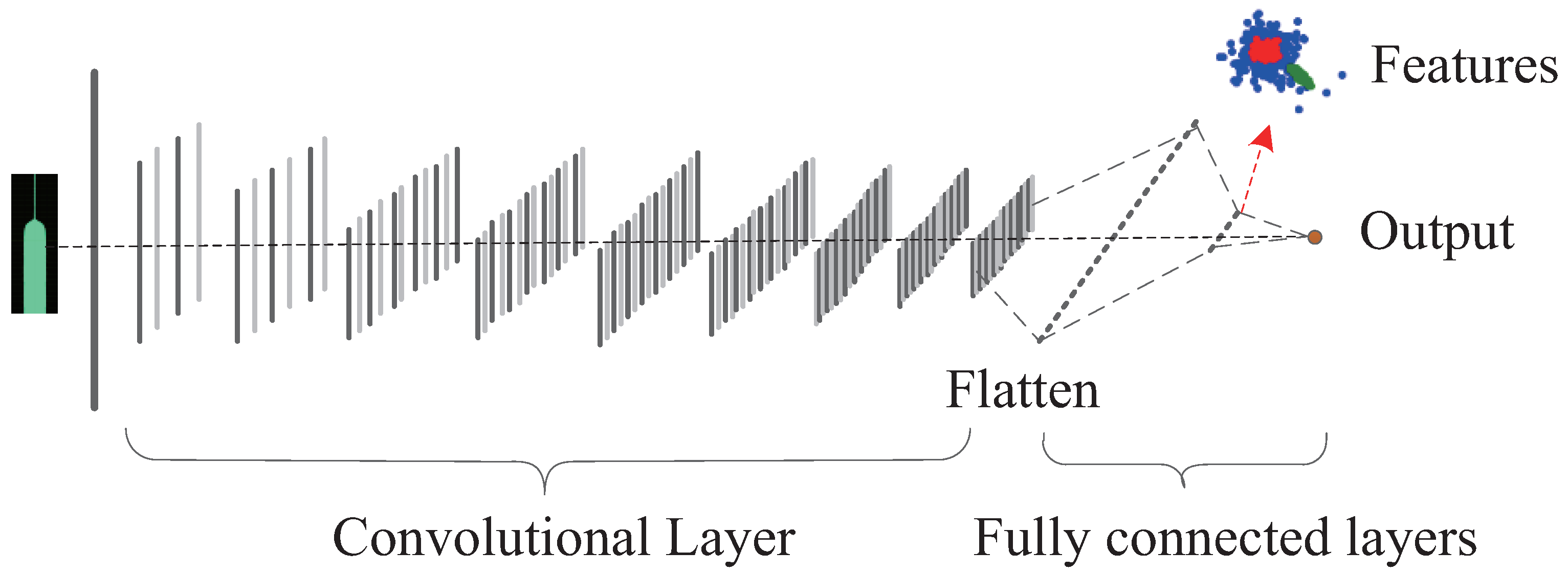

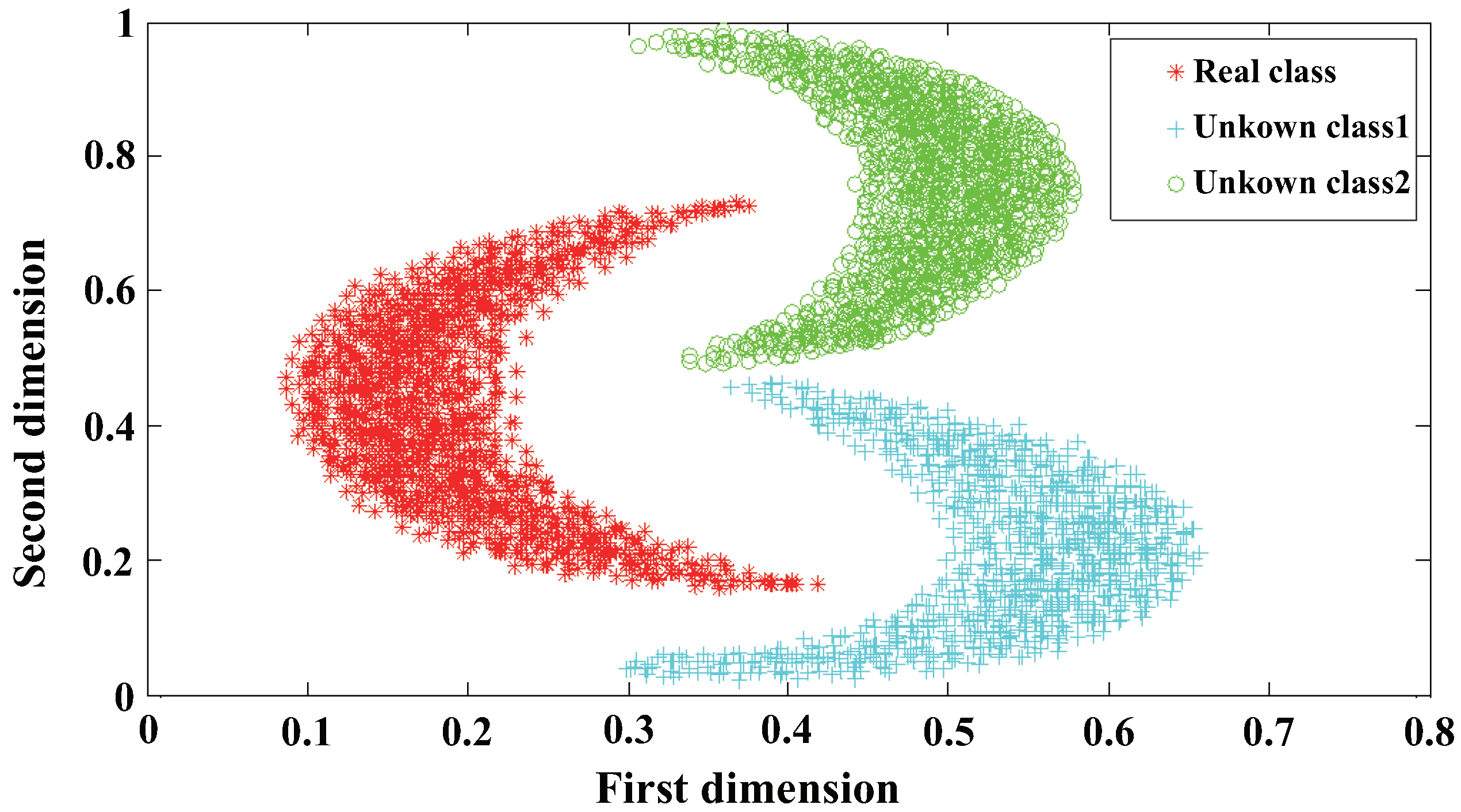
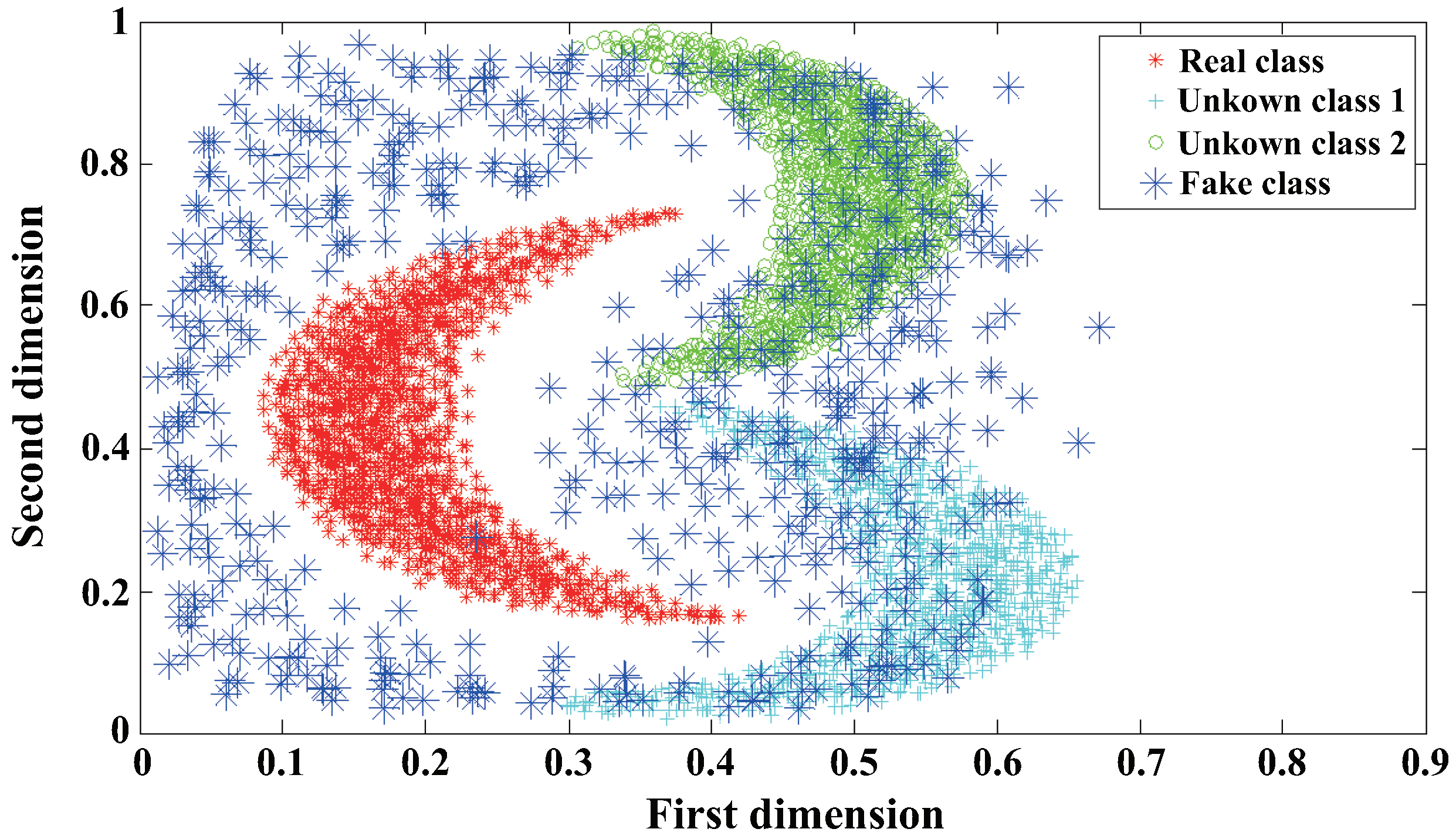

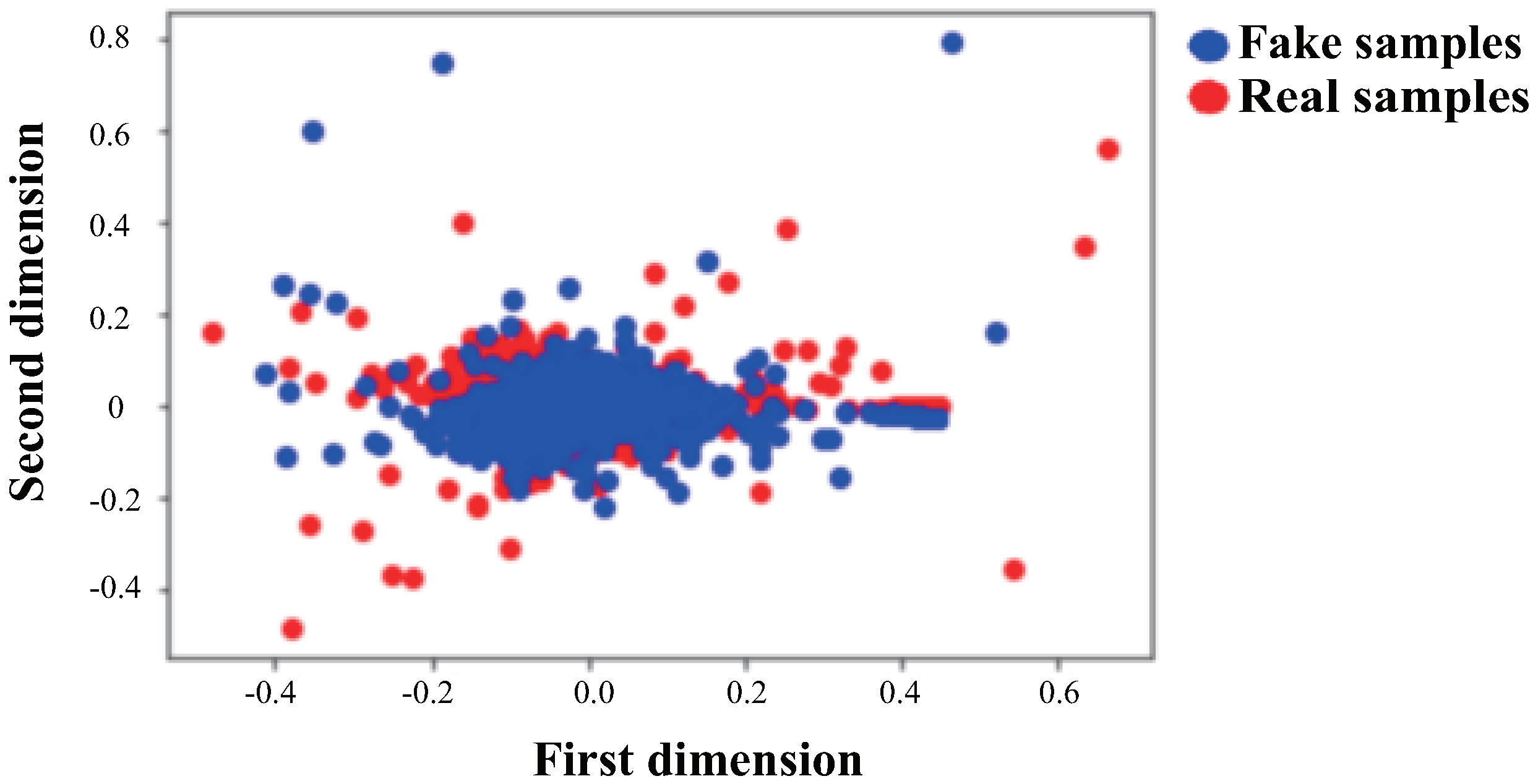
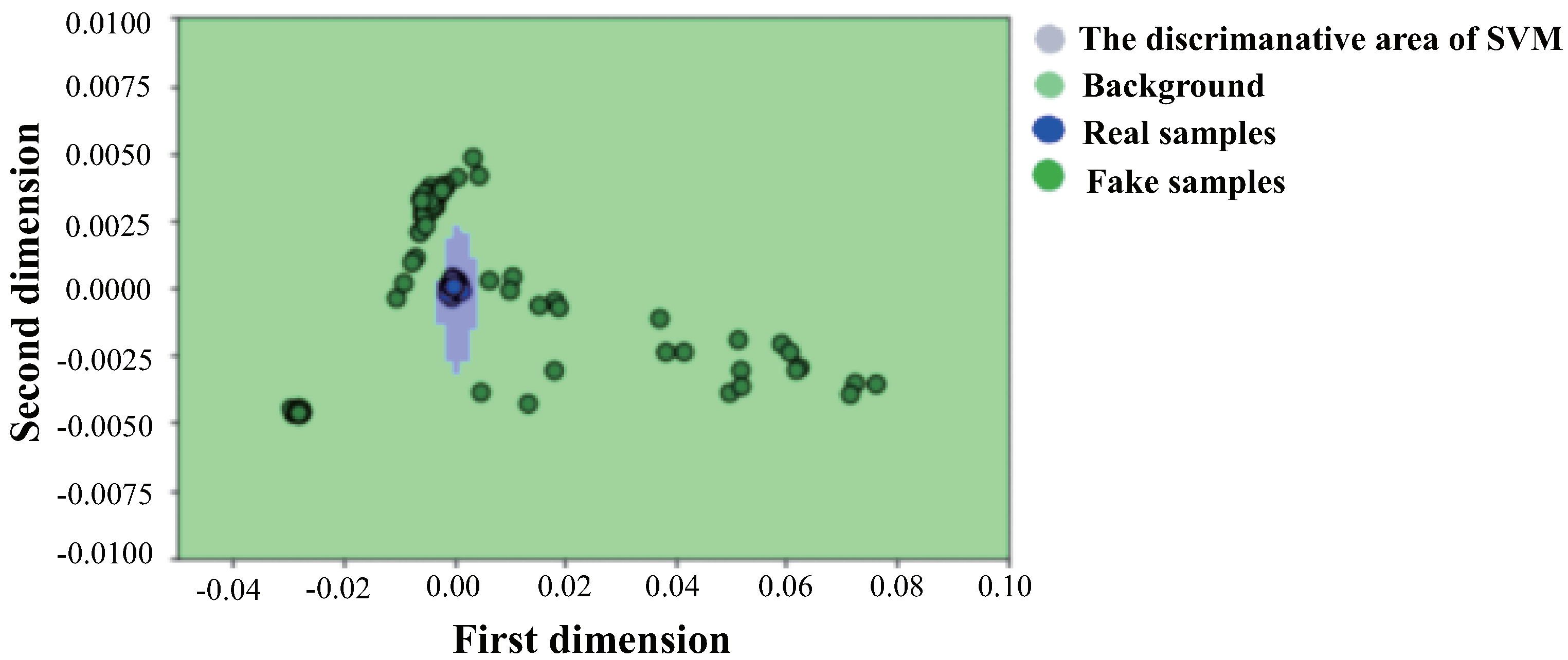
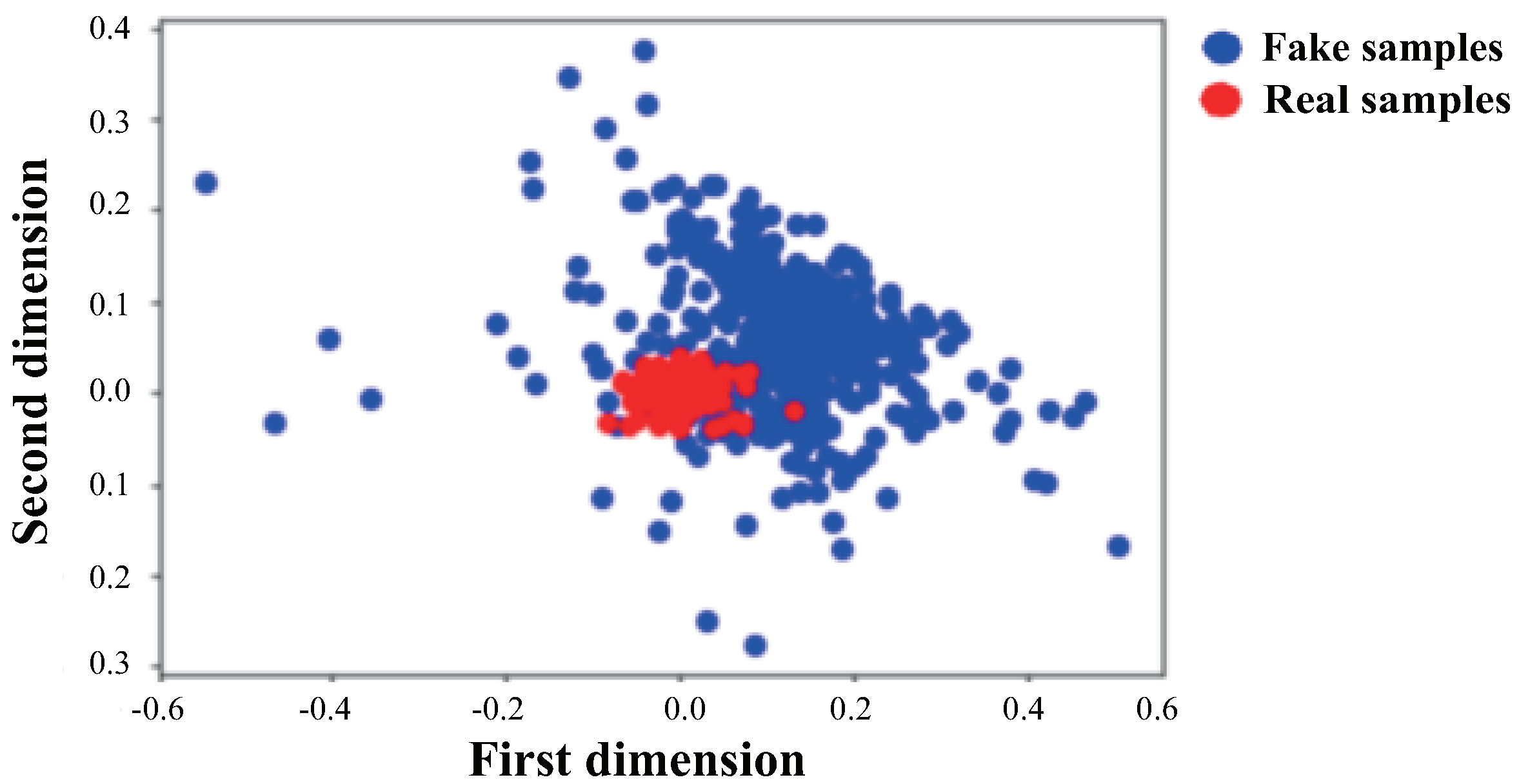
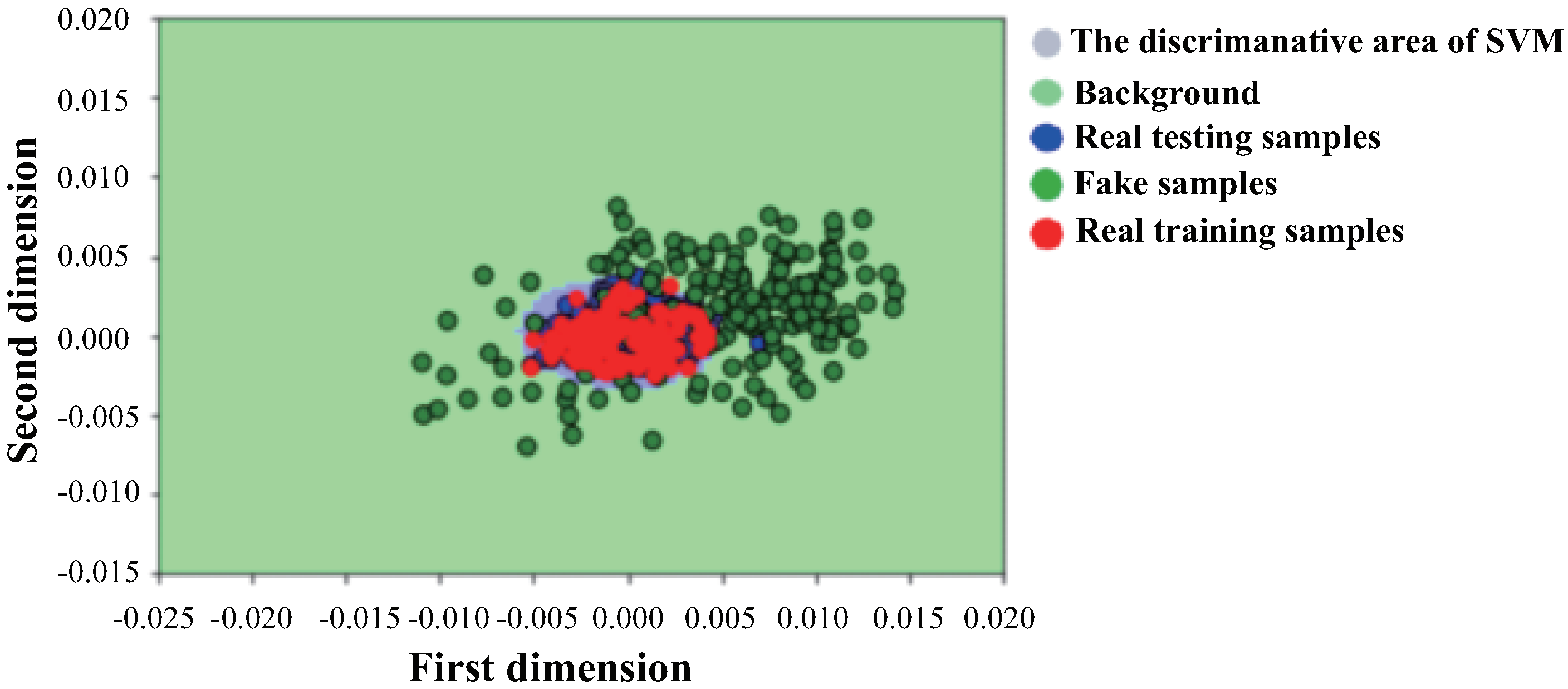
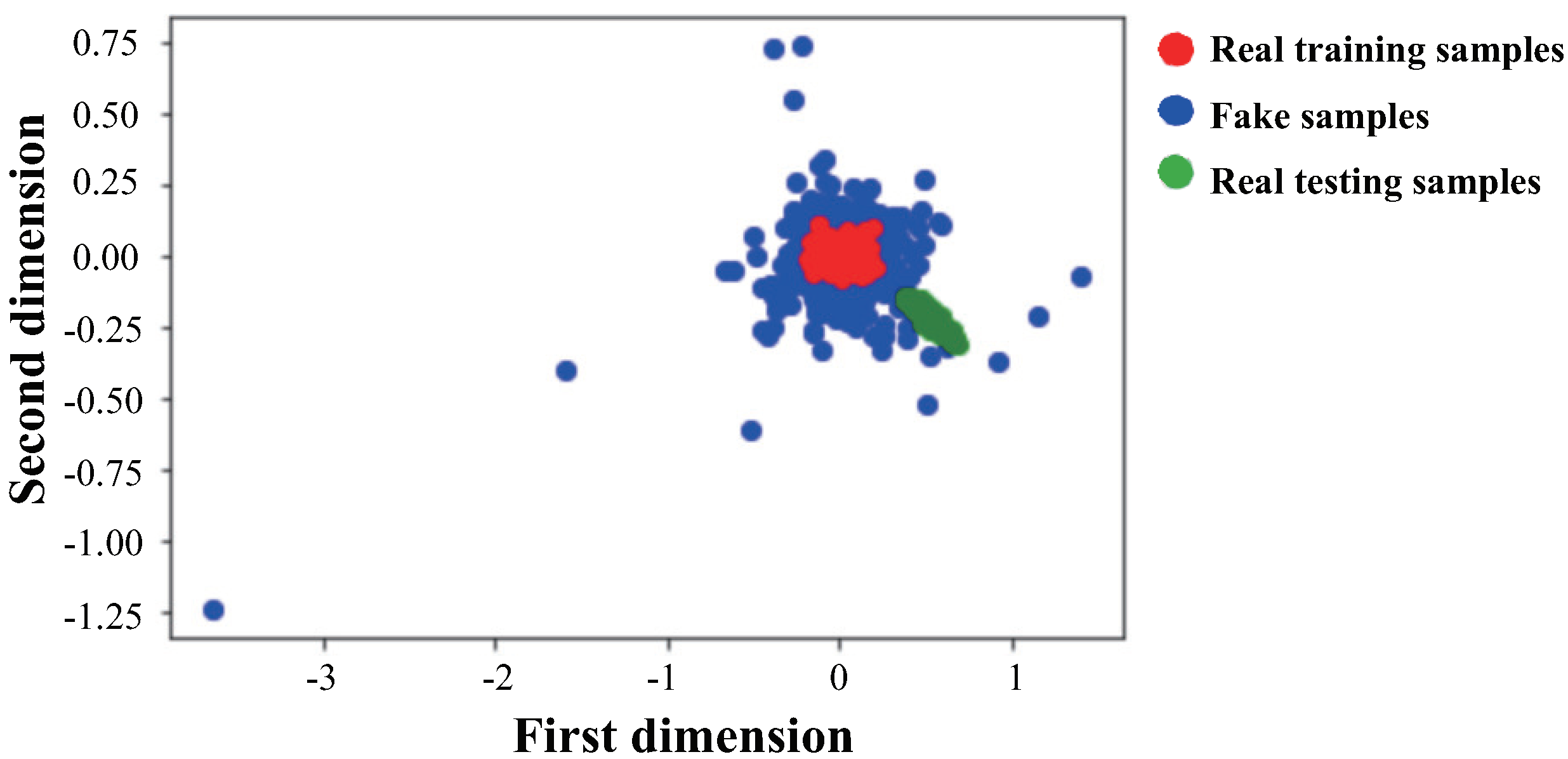
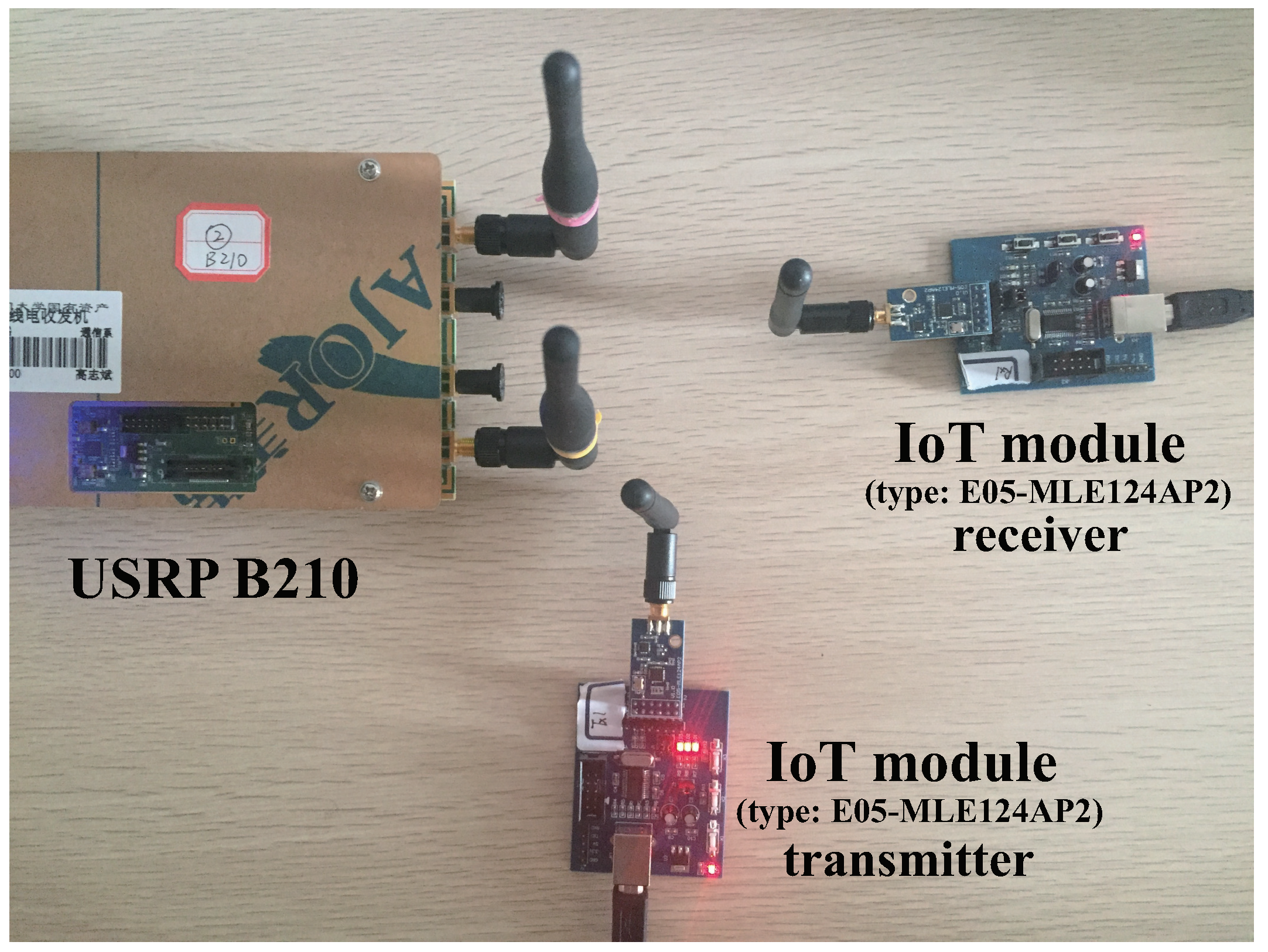
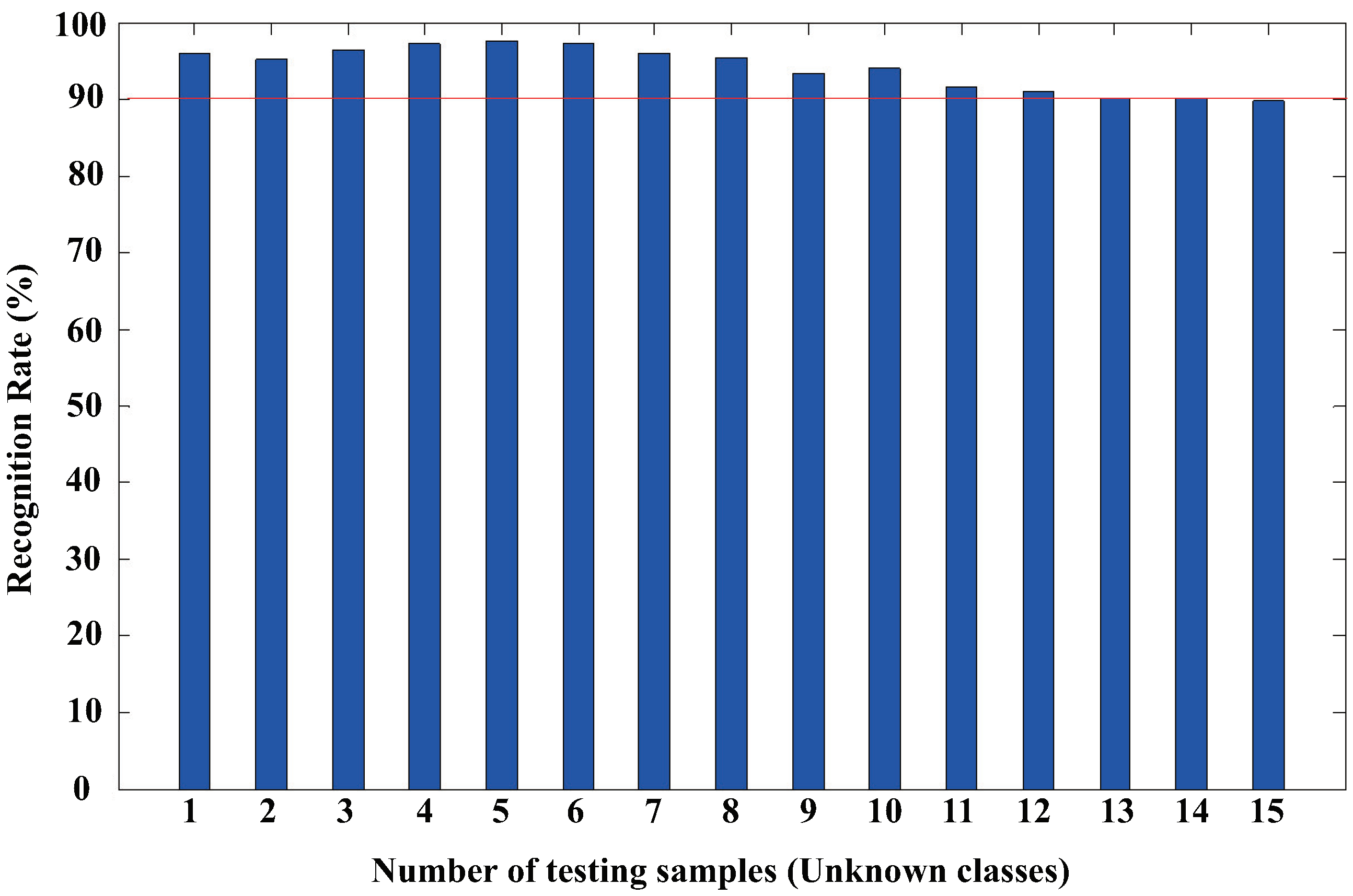

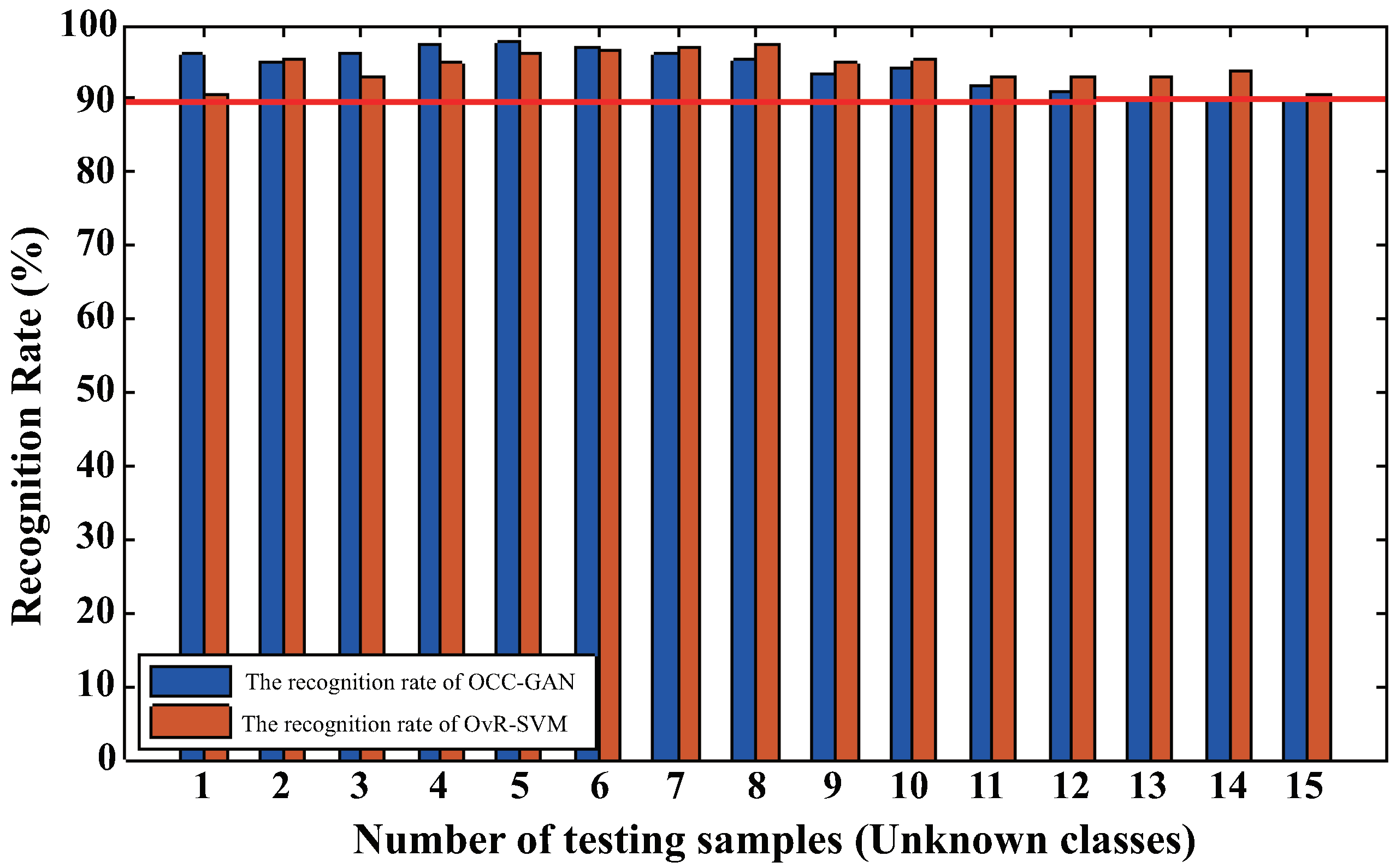
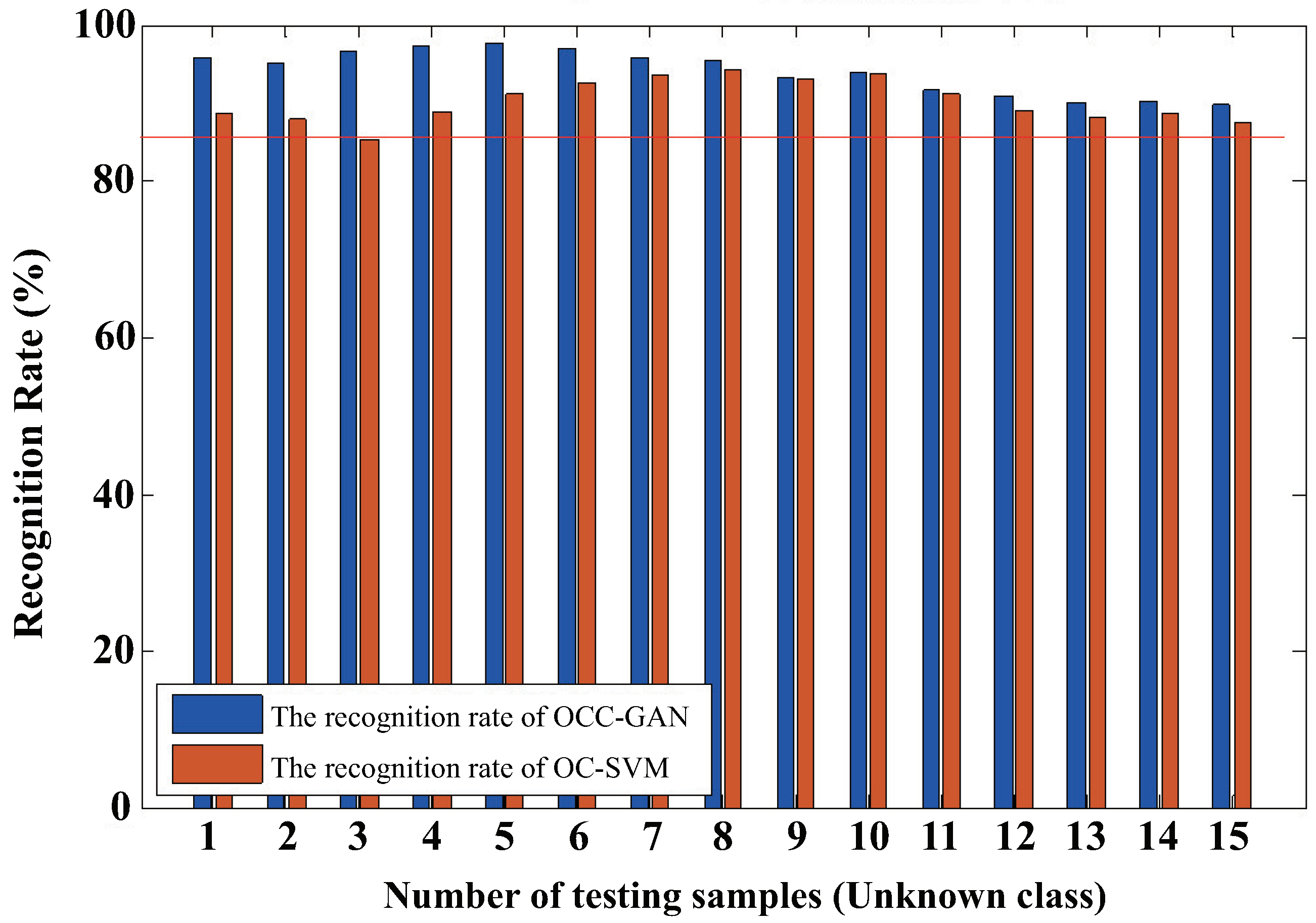
| OvR-SVM | OC-SVM | OCC-GAN | |
|---|---|---|---|
| F1 | 0.802 | 0.923 | 0.939 |
© 2018 by the authors. Licensee MDPI, Basel, Switzerland. This article is an open access article distributed under the terms and conditions of the Creative Commons Attribution (CC BY) license (http://creativecommons.org/licenses/by/4.0/).
Share and Cite
Zhao, C.; Shi, M.; Cai, Z.; Chen, C. Research on the Open-Categorical Classification of the Internet-of-Things Based on Generative Adversarial Networks. Appl. Sci. 2018, 8, 2351. https://doi.org/10.3390/app8122351
Zhao C, Shi M, Cai Z, Chen C. Research on the Open-Categorical Classification of the Internet-of-Things Based on Generative Adversarial Networks. Applied Sciences. 2018; 8(12):2351. https://doi.org/10.3390/app8122351
Chicago/Turabian StyleZhao, Caidan, Mingxian Shi, Zhibiao Cai, and Caiyun Chen. 2018. "Research on the Open-Categorical Classification of the Internet-of-Things Based on Generative Adversarial Networks" Applied Sciences 8, no. 12: 2351. https://doi.org/10.3390/app8122351
APA StyleZhao, C., Shi, M., Cai, Z., & Chen, C. (2018). Research on the Open-Categorical Classification of the Internet-of-Things Based on Generative Adversarial Networks. Applied Sciences, 8(12), 2351. https://doi.org/10.3390/app8122351





